

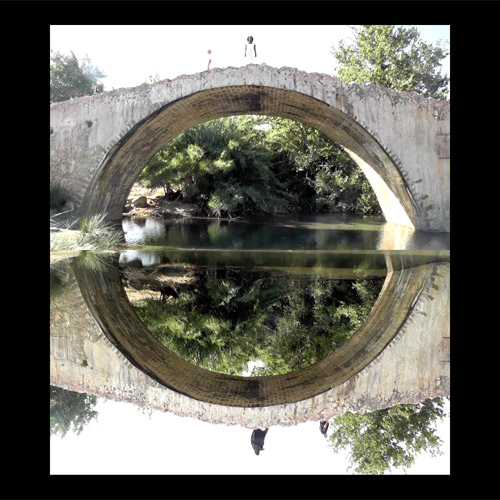
| *works << >> |
BRIDGE - GEFFIRA MEGALOU POTAMOU (video 14'41'' / 2013/2016) |
watch the video >> |
| Background
text to
NEQAB works > An old Stonebridge arches over a river in a semicircular manner. The video consists of two recordings showing the rounded bridge that primarily appears mirrored. While one recording is displayed from a “normal” perspective, the other recording is rotated by 180 degrees – upside down. Both recordings are assembled vertically, hence creating the illusion of the bridge forming a circle (with itself). At first, geese swim along the image that seems mirrored. Next, a woman wearing a white dress appears in the top recording at the crest of the bridge. As she stands there motionless, her dress blows in the wind. Simultaneously, another woman wearing a black full body veil (Neqab) is shown in the bottom picture. Similarly, she stands (upside-down) inertly, with only her Neqab flowing in the wind. Slowly, a man, above dressed in white and below wearing black, wanders along the rounded bridge. Resembling a slow pendulum, the man sways along the rounded bridge, passing the still women at the crown of the bridge. Eine alte Steinbrücke wölbt sich halbrund über einen Fluss. Das Video besteht aus 2 Aufnahmen der Rundbrücke, die zunächst wie gespiegelt erscheint. Eine Aufnahme ist in „normaler“ Ansicht. Eine Aufnahme ist um 180 Grad gedreht - auf dem Kopf stehend. Die Aufnahmen sind vertikal zusammengefügt wodurch die Brücke einen Kreis (mit sich selber) bildet. Zunächst schwimmen Gänse wie gespiegelt durchs Bild. Dann erscheint eine Frau in weißem Kleid in der oberen Aufnahme am Scheitel der Brücke. Sie steht dort regungslos, nur ihr Kleid weht im Wind. Gleichzeitig erscheint auch auf der unteren Aufnahme eine Frau in schwarzer Ganzkörperverschleierung (Neqab). Sie steht (kopfüber) ebenfalls regungslos, nur ihr schwarzer Neqab weht im Wind. Langsam wandert ein Mann, oben in weiß, und unten in schwarz gekleidet, über die Rundbrücke. Wie ein langsames Pendel geht er hin und her über die Brücke und an der stehenden Frau in der Mitte der Brücke vorbei. |
 |
 |
 |
| *works << >> |
NEQAB / PREVELI (video 4'01'' and photos / Crete, June 2013) |
watch the video >> |
| Background
text to
NEQAB works > Video: This video is set at a spring located in the mountains. Small waterfalls flow from the lush green hills. A woman dressed in a Neqab stands in the course of the river. Masses of rock rise from the water. The wind blows through her clothing. Carefully, she works her way through by setting her feet from stone to stone. Due to the limited vision caused by the veil in addition to her obstructing clothing, her steps seem dramatically instable, making her movements look awkwardly quivery. At times, she appears to be close to falling down. Video: Ein sprudelnder Flusslauf im Gebirge. Von den grün bewachsenen Hängen fallen kleine Wasserfälle. Im Flusslauf steht eine Frau im Neqab. Steinkuppen ragen aus dem Wasser. Wind bläst durch ihre Kleidung. Vorsichtig setzt sie ihre Füsse von Stein zu Stein. Wegen der eingeschränkten Sicht durch den Schleier und der hinderlichen Kleidung sind ihre Schritte dramatisch wackelig, Ihre Bewegungen zitterig unbeholfen. Mitunter stürzt und fällt sie beinahe. |
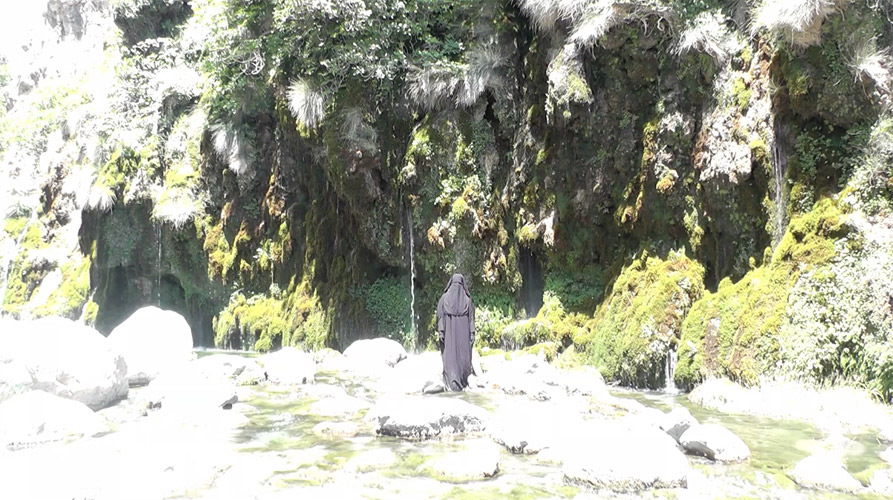 |
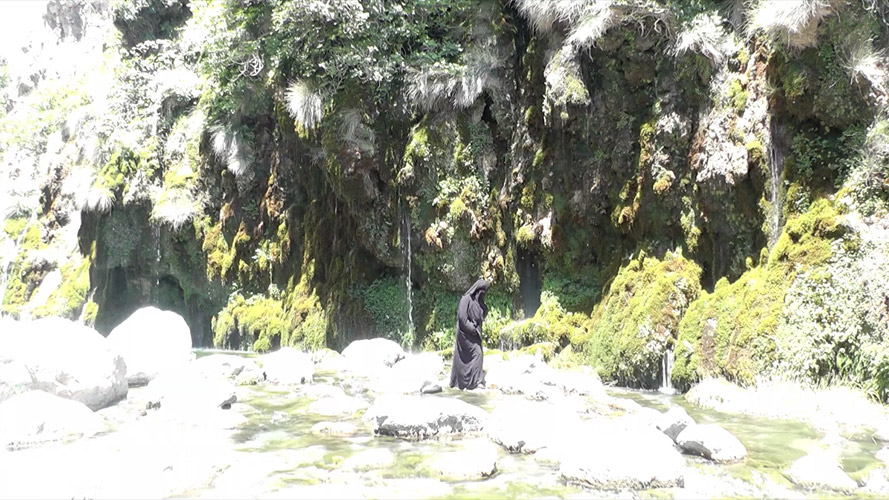 |
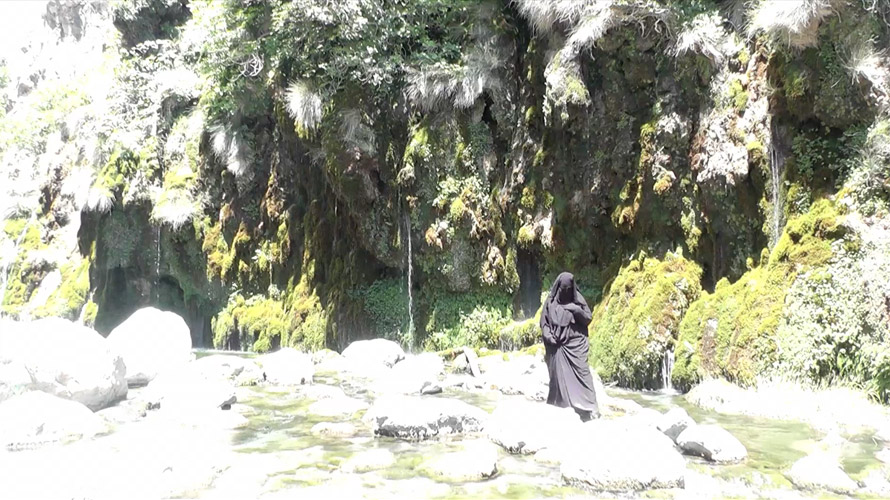 |
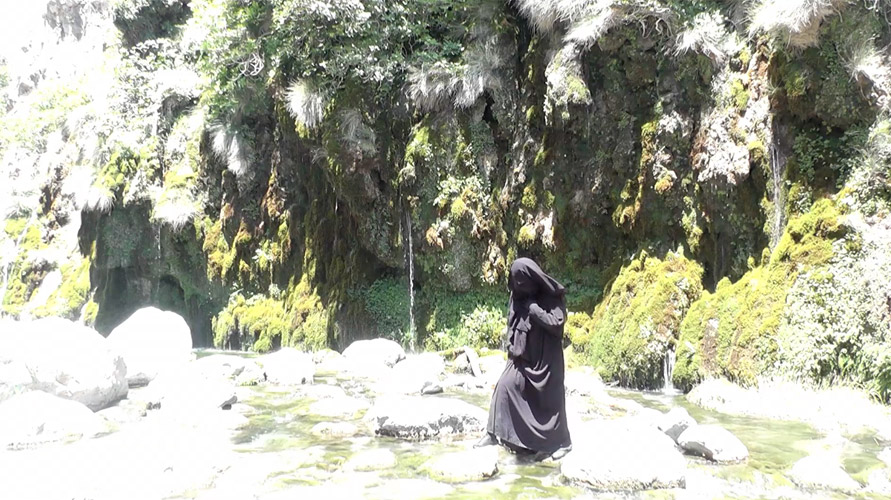 |
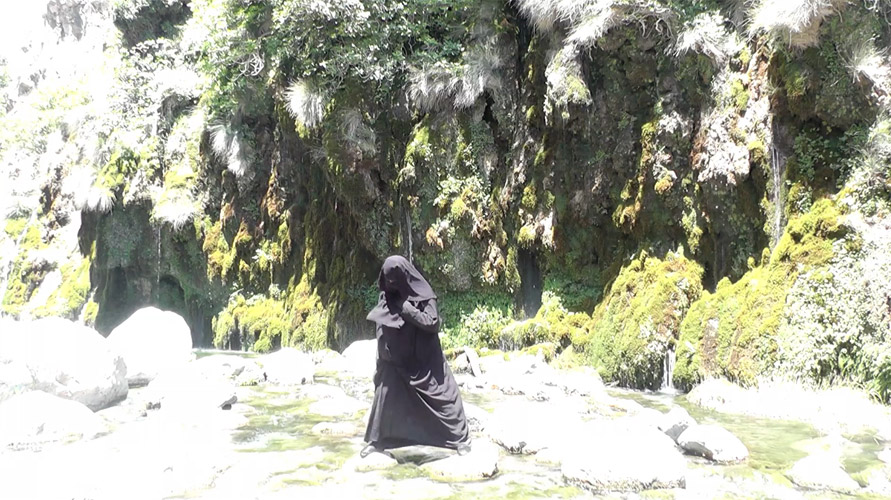 |
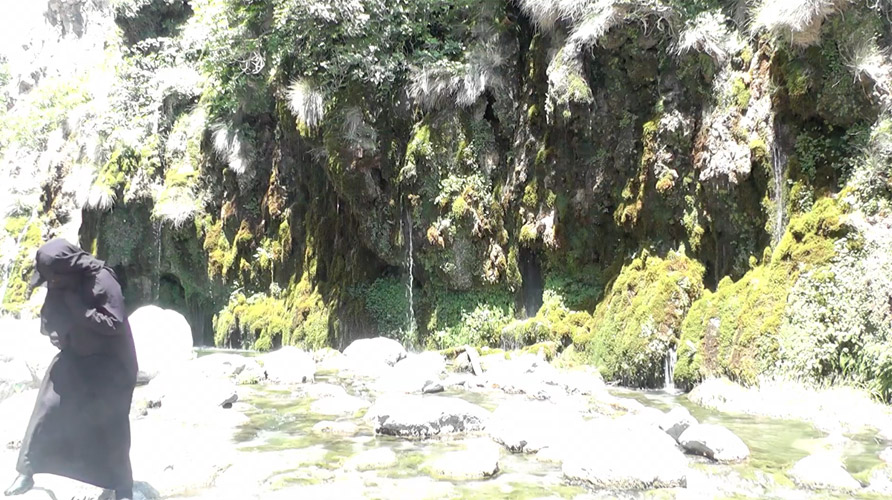 |
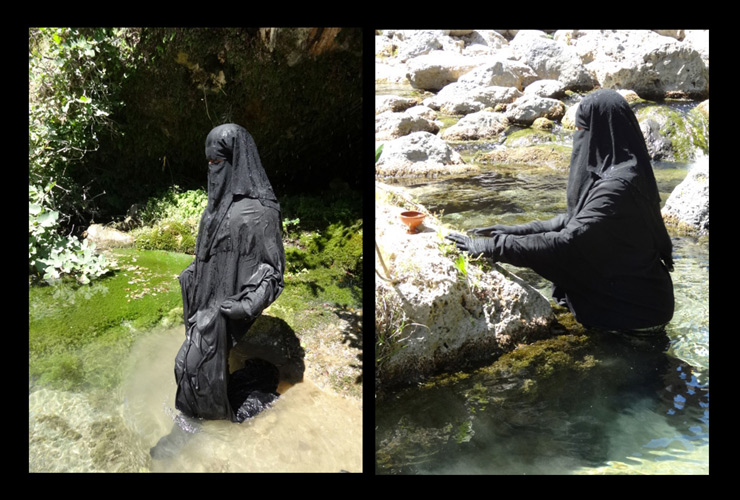
| *works << >> |
NEQAB / LYBIAN SEA (video 11'17'' / Crete, June 2013) |
watch the video >> |
| Background
text to
NEQAB works > A woman wearing a Neqab stands on a rock that is surrounded by water in the middle of the sea. The leveled horizon of the sea behind her steadily moves along the length of her body – from her hips to her neck until it eventually reaches above her head. Eine Frau im Neqab steht auf einem vom Wasser umspülten Felsen im Meer. Der waagerechte Meereshorizont hinter ihr reicht ihr erst bis zur Hüfte, dann bis zum Hals und schliesslich bis über ihren Kopf. |
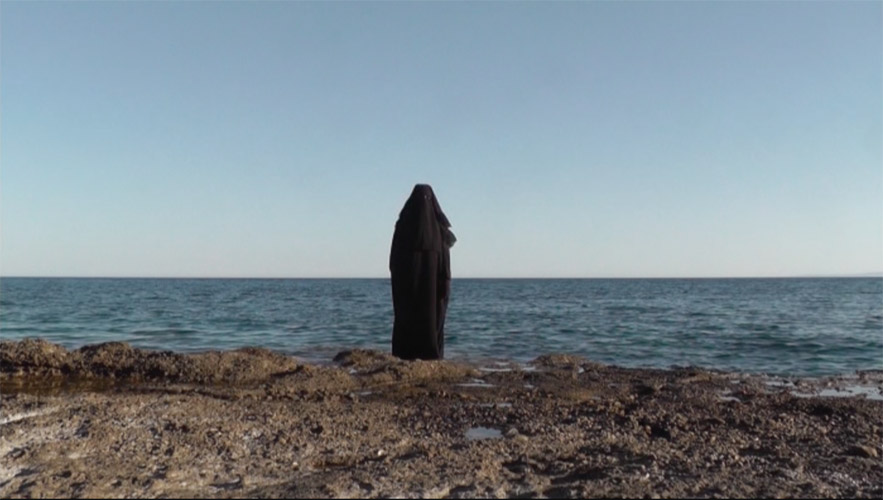 |
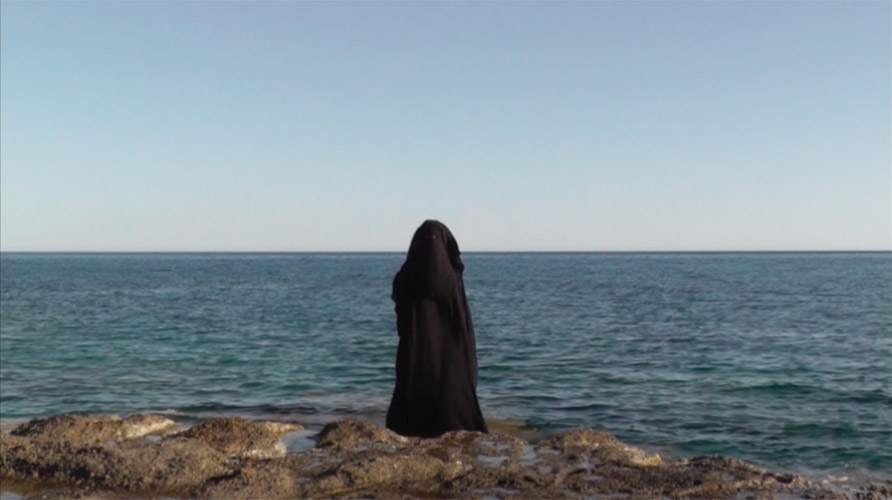 |
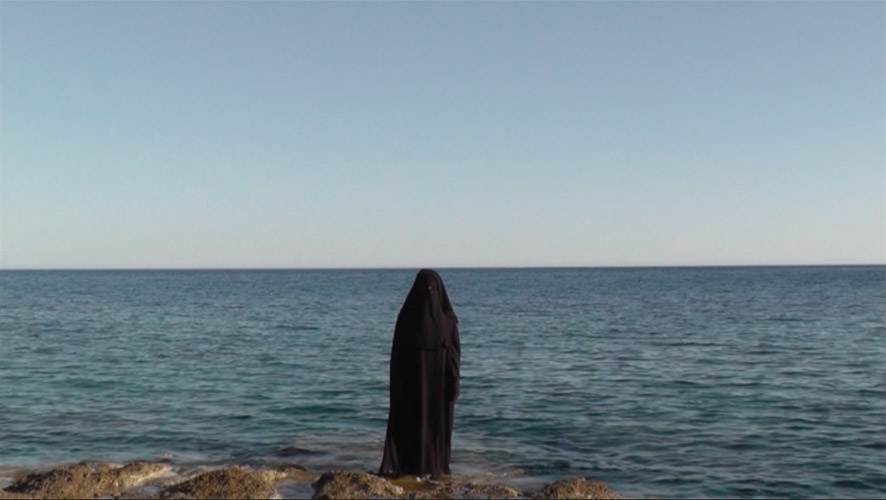 |
| *works << >> |
NEQAB / SAYAL (video 8'40'' / Crete, June 2013/16) |
watch the video >> |
| Background
text to
NEQAB works > A woman wearing a Neqab stands in a small hut with numerous windows. Inside the hut a timeworn wooden oven, a table along with a stack of old newspapers are visible. The windows reflect surrounding bushes and trees that powerfully blow through the forceful wind. A white greyhound alongside a fleshy bone are positioned next to the motionless woman. Occasionally, the dog nibbles at the bone, while smelling and licking the former and his genitalia. Afterwards, he walks to a grass tuft which he proceeds to chew on. The spectator’s attention focuses on the dog as the woman disappears to a neuter. Eine Frau im Neqab steht in einer kleinen Hütte mit vielen Fenstern. In der Hütte ist ein alter Holzofen und ein Tisch mit einem Stapel alter Zeitungen. Durch die Fenster sieht man sich stark im Wind wiegende Büsche und Bäume. Neben der reglos stehenden Frau befindet sich ein weißer Windhund und ein fleischiger Knochen. Manchmal nagt der Hund an dem Knochen, manchmal riecht oder leckt er an ihm oder seinem Geschlecht. Nach einiger Zeit geht er zu einem Grasbüschel und kaut an diesem. Die Aufmerksamkeit des Betrachters richtet sich auf den Hund. Die Frau verschwindet zu einem Neutrum. |

Background to NEQAB The videos and photos depicting the (Neqab) a garment covering the whole female body were created in the light of the steadily increasing power of the Muslim Brotherhood in Egypt and the worry that women may soon be forced to wear this garment in public places. The videos and fotos were created in June 2013 in Crete, the close European island to Egypt. The occasion among other things was an exhibition with performance in Munich. Rasha wrote down in a kind of diary her mournful feelings and thoughts while she was buying the clothing and during two shots. Thursday, 20 June 2013 Ataba-square, Cairo, Egypt A very lively square in Cairo, it was very hot with temperatures rising above 40°c that day. I pushed my way through the crowds, trying to find a Neqab (a black full-body and face covering worn by some muslim women) or a Khemar. (also a full body covering, but here the face is a little more free) I went in a clothes shop where all the men working there had long beards and stared at me with a distainful look in their eyes, even though I was wearing a pair of trousers, and a long-sleeved blouse that was buttoned right up to the top. „Where can I buy a Neqab?“ I asked. „Go behind this curtain, and the girls in there will help you“. I lifted the curtain and then a second (curtain). There I found some women and girls who looked at me strangely, probably because I was the first woman in the shop neither wearing a Neqab, a Khemar, or even a headscarf. I thought, perhaps I could tell them I wanted to buy a Neqab for my sister, or for a girlfriend but this was unecessary as all the women in the shop, even the customers, immediately and enthusiastically came to my aid offering their advice. The shop assistants happily made a great effort to bring me all those Nequabs, that were easy to put on. One assistant called another colleague and told her that I was going to wear a Neqab for the first time. „Bring her a model which is lightweight and easy-to-wear“ she said. Even the other customers offered help and explained how to put on such a garment. I was torn between telling the truth that the Nequab was not really for me, or pretending God had shown me the light and the right way to dress in a chaste manner instead of being 'naked'. Everybody helped me to put on the Neqab. I felt as if I´d entered a dark room. I saw people as if through a veil or several layers of thick fabric through which one can hardly see. I started sweating and could hardly breathe. I tried to bear this moment but could not, and felt like crying. I wanted to get out of the Neqab as fast as I could. My heart was pounding, I was nervous and flustered, I hastily shed the Neqab. Everyone around me was bewildered. To avoid insulting them I just said „How can you wear this when the weather is so hot?“ Nobody replied. Saturday 22 June 2013 Frangokastello, Crete The old fortress now in ruins, has witnessed many wars. Within the castle walls I put on the Neqab and stood in a corner, where I began to contemplate how I had chosen to cast myself into a dark tent or a pitch-black barrel. I thought about all the women who either choose to, or are compelled, to wear the Neqab.These women wear the Neqab because of social pressure, their family, husband, father, uncle, or because of the neighbours. I thought, how can a woman be ashamed of their own bodies which are a gift from God? Does anybody give any thought about how these women feel when walking in the streets, travelling on the underground, or sitting at their desks at work? I thought that my body is not free, so my body rejects this garment. Every drop of sweat running down my skin, beneath this Neqab, feels like tears, my body cries out against this repression, force, and imprisonment. Should I be ashamed??? Am I `haram´ (forbidden). Why did God make me this way? Ask the women and girls who either choose to, or are compelled to wear the Neqab, whether, in so doing, their bodies are happy and satisfied, or sad? All that causes me great pain, and I deeply regret it. I find that the Neqab is a veil for the mind. This garment casts my mind into darkness, and that frightens me. I am frightenend that Egypt, my country will one day force me to wear a Naqab. What shall I do? I would rather stay at home than go outside with my body imprisoned in a Naqab, as others want me to. I would rather my body be imprisoned at home than my soul within a garment. Sunday 23 June 2013 Plakias, Crete A place by the sea, where it is difficult to move. Christoph climbed some rocks to try and find the highest possible place to film the the performance. Being dressed in all my heavy clothes was weighing heavily on my soul. After he had asked me to climb on to another rock and then another higher up, my rebellious nature took over and I completely refused to take another step, because I was afraid I might injure myself. I started to think that I could not climb beyond the point where I felt safe. The search for a suitable location had taken more than an hour. Christoph tried to motivate me to climb as high and as far as possible, and jokingly quoted the female author Marina Abramovic: ´We have to die for art´ The search came to an end as we found a secluded sandy bay where we just did nothing but swimming and relaxing, untill we later found the ideal place. When we arrived Christoph found a rock which looked like a bed in the sea, but it was rough and had sharp edges, and one could not walk barefoot upon it. We stood on the edge of the rock and decided to start the performance at this point. Dressed in the Neqab, I stood with my back to the sea and my face to the shore, where people were sitting with (or even without) their bathing wear. After five minutes I started to sweat in this black dress, and I felt sadness in my body and on my skin.Once again my body began to weep. I thought to myself that I should just fall backwards into the sea and dash myself upon the jagged rocks under the water - I thought that more than once - but did not do it. I thought that I must concentrate on something else, something more pleasant. I noticed that some spectators were taking photographs of me, this figure completely covered in this black robe. I felt how Christoph was watching me from behind the camera, trying to give me the strength to endure, he too felt the deep sadness in my body and heart. I can not stand wearing this garment. These heavy feelings of sadness fill my body, heart and soul. |